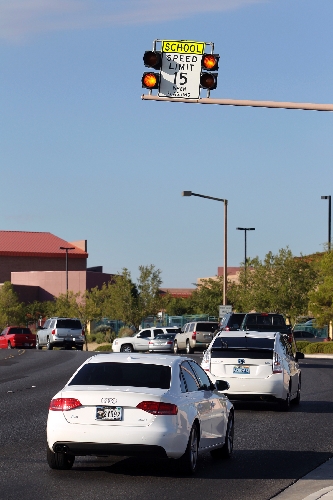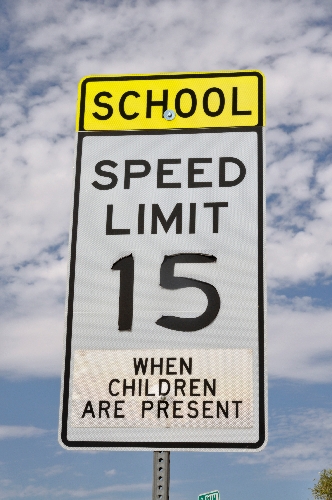Slow down when children are present or not
The beginning of a new school year can be expensive, even it you don't have to buy books and clothes for your children. In fact, it can be pricey even if you don't have children.
It's the time of year when those yellow lights begin to flash overhead and motorists dealing with 112-degree heat forget that summer is over and a new school year has begun. Don't get caught off guard and nailed with a speeding ticket and fine that typically hovers above $200.
Sometimes I wonder if I should be the one heading back to school, because I can't figure out those signs that ask you to slow to a crawl "When Children are Present." The warnings adjacent to schools seem vague and certainly open to interpretation. One child? Two? Day or night?
Some communities responded to complaints about school zone speed limit signage by adopting a single uniform sign, which makes sense. In Milwaukie, Ore., for example, the new signs simply say: Speed limit 20. School days. 7 a.m. to 5 p.m.
Simple enough.
Clark County School District Lt. Ken Young said local governments have discussed using the same signage, but so far nothing has been done. That is why we have "When Children are Present" signs, flashing amber lights and warnings with specific times when the reduced speed limit is in effect.
The flashing lights seem the most reasonable and straightforward: When the lights are flashing, slow down. Drivers don't even seem to mind the warnings with specific times, except to complain that the print is small and tough to read on the go.
Studies have shown that the "When Children are Present" warnings, which began to appear around the Las Vegas Valley three years ago, are most effective. Drivers tend to slow down no matter the time of day, wondering whether a child might be behind a tree, around the corner or under a rock.
"It's always a good thing to slow down when you think children might be present," said Keith Paul, spokesman for the Henderson Police Department. "It serves as a reminder to drivers, even if they don't have children, to slow down, look around and pay attention."
Paul's city recently introduced yet another sign that says: "Fines are Higher" and "Effective When Children are Present." Paul said this means fines for motorists caught exceeding school zone limits are higher than regular speeding tickets.
The question in most motorists' minds is when the reduced speed limit is enforced. Young said children are considered present when they are exiting the school bus or walking to campus in the morning or boarding the bus or walking home in the afternoon. According to Nevada laws, the reduced speed limits are enforced a half hour before classes begin and a half hour after school ends.
For readers who have no children, here is a guideline as to when that might be: High school students typically start classes between 6:30 a.m. and 7 a.m. and leave school between 1:20 p.m. and 2:15 p.m.; middle schools begin between 7 a.m. and 8 a.m. and end between 2 p.m. and 2:15 p.m. and elementary schools start between 8:15 a.m. and 8:30 a.m. and let out between 3 p.m. and 3:20 p.m.
Many readers have asked whether they will be ticketed for driving the normal speed limit when school is in session, but no children are visible or, if they are, they are in recess protected by a fence. The answer is no, Young said. If the reduced speed is enforced during classes, the sign will specifically list the hours of enforcement.
The various speed limits can also be confusing, although the municipalities, who determine speeds around schools, are working to make them more consistent.
Speed limits on streets directly adjacent to campuses are typically 15 mph in school zones, which are 300 feet long. Sometimes you might come across a 25 mph sign and wonder why, since no school is in sight. For example, flashing lights signal traffic on Charleston Boulevard to slow down, but the nearest campus is Wasden Elementary School, a block away. Those streets are considered school crossings or common roads used for students walking.
The 25 mph school crossings are mostly controlled by flashing amber signals.
Law enforcement agencies do not determine the fine for speeders; the penalty is handed down by the courts.
The final lesson in Understanding Confusing School Traffic Laws 101 is what the heck to do when a school bus comes to a halt, flashes its red lights and flips out its little stop signs.
This scenario might be familiar: You are headed west and an eastbound bus stops. Your heart pounds, and you tap your brakes. You look around to see what other motorists are doing. You see some drivers stopping, some continuing and some doing the same thing you are doing.
If the bus is traveling on a street that does not have a concrete median, traffic in both directions must stop while students exit the bus. However, on larger arterials that have median islands, oncoming traffic does not have to stop. Students have a "safe zone" if they are crossing the road, Young said.
Unlike speeding fines, the penalties for failing to adhere to these rules are clear in the state law. First-time offenders will receive four demerit points on their licenses and a fine between $250 and $500.
If the second offense is within a year, the driver's license can be suspended for six months and the same fine range applies.
Third-time offenders within a two-year period will have their license suspended for a year and be slapped with a fine up to $1,000.
School starts Monday. Keep the students safe and your money in your pocket.
If you have a question, tip or tirade, call Adrienne Packer at 702-387-2904, or send an email to roadwarrior@reviewjournal.com. Include your phone number.
• Beginning at 9 a.m. Monday and lasting until Sept. 12, eastbound Tropicana Avenue will be reduced to three lanes. Dedicated right-turn lanes at Tropicana and Paradise Road will be closed. The closures are due to crews installing an electronic sign across Paradise.
• From 9 tonight until 6 a.m. Monday, first eastbound and then westbound lanes on St. Rose Parkway will be closed between Eastern Avenue and Coronado Center Drive as crews work on a pedestrian bridge.
• From 9 tonight until 7 a.m. Monday, Rainbow Boulevard will be reduced to one lane in each direction at Westcliff Drive and Westcliff will be closed at Rainbow while Rainbow is repaved.
• Beginning Monday and lasting two months, Ann Road will be reduced to one lane in each direction between Durango Drive and Centennial Center Boulevard for a maintenance project. Construction hours are from 9 p.m. to 5 a.m.
• For the next eight months, the ramp from Las Vegas Boulevard to northbound Interstate 15 will be closed 24 hours a day. Traffic will be detoured. Also, westbound Interstate 215 traffic headed to northbound I-15 will be diverted to a temporary ramp about 1,500 feet west of the current ramp. The closures are to allow crews to work on bridges and walls in the area.
• For the next month, the left lane of I-15 south will be closed between Russell Road and Sunset Road. Lanes will shift to the right. The third lane from the left might continue southbound or exit onto I-215 east. The fourth lane from the left can access only I-215 east or west. The configuration will be in place 24 hours a day to accommodate work on express lanes.
GASOLINE PRICES
The average price of gasoline in the Las Vegas Valley on Friday was $3.47 per gallon; the current state average is $3.50; the national average is $3.60. Find the Las Vegas Valley's best deals at gasbuddy.com.
Las Vegas Review-Journal


















